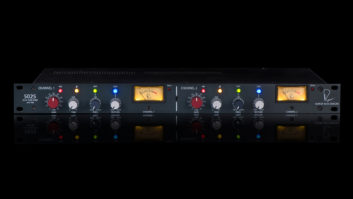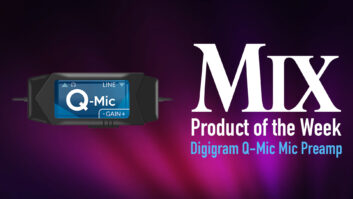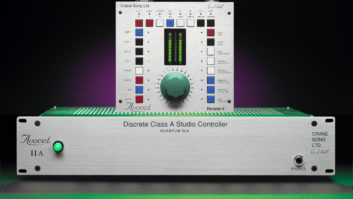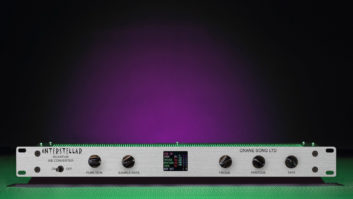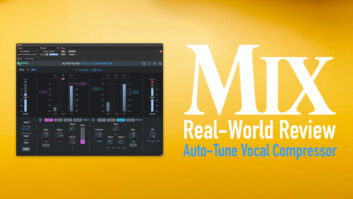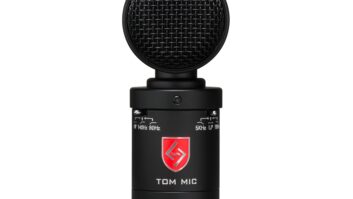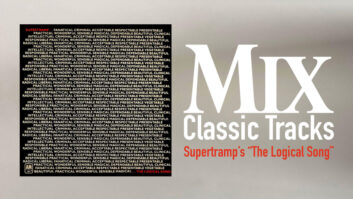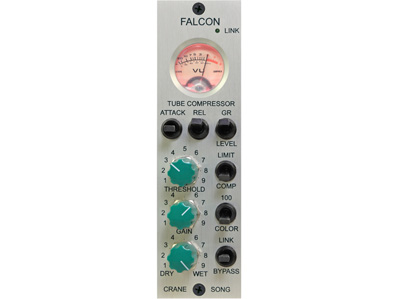
The Syren Microphone Pre-Amp and Falcon Compressor/Limiter are single-slot 500 Series tube-based modules. Both use a single 12AX7 tube running in Class-A that’s vertically mounted in a ceramic socket with cooling vents cut in the top of the modules’ cases. The tubes are carefully selected and tested for lowest noise, and all units use mu-metal shielded LL1585 Lundahl output transformers.
For these modules, Dave Hill designed a voltage converter on an internal “daughter board” to derive both the tube’s 5-volt filament voltage and 185VDC plate supply. Carefully tuned input and output EMI filters are used to prevent the power supply’s 600kHz switching noise from polluting the audio, the 500 rack’s ±16-volt power supply rails and other modules in the same rack.
The Falcon Compressor
The Falcon uses a variable impedance circuit to change gain in a feedback-styled compressor design. The compression ratio varies depending on the amount of gain reduction—mimicking the characteristics and operation of an opto-compressor. The Comp/Limit front-panel switch selects between soft-knee and hard-knee curves. This gain control element is followed by a tube makeup amp with output Gain control.
Falcon is a colorful all-analog compressor with two operational modes controlled by the front panel’s 100/Color switch. The flattest and cleanest mode is 100, with no negative feedback; the Color mode uses negative feedback for a more euphonic and creamy tonality.
I liked the Wet/Dry control knob for immediate parallel processing—with no need to do external patching, there are no phase/polarity issues possible.
Attack and release times are set using a pair of three-position toggle switches, each simply labeled Attack and Release, with the top position the fastest. Both attack and release times are specified for a 12dB gain change, and I found all three choices to be effective with the middle or medium positions as good starting points.
At the bottom of the Falcon front panel is a three-position toggle switch with Bypass, In Circuit and Link positions. In Bypass (down), a nitrogen-filled NEC relay back on the unit’s edge connector is triggered for true hardwire bypass. The middle position puts the compressor in circuit, and in the up position, link mode.
Any Falcon compressor can be configured to serve as master or slave with up to six Falcons linkable for surround mixing. The attack, release, output/GR meter switch, color, threshold knobs and switches on the designated master will simultaneously control those controls and switches on all slaved Falcon compressors. All compressors linked will track to within 0.1 dB of each other.
I tried the Falcon on many sources, and since there is no separate input level control, I found that hot source levels give the largest operating threshold range for invisible to extreme compression.
As a bass guitar compressor, I found the 100-position to be cleaner, with the middle attack and release times perfect. The fastest release time setting will work with minimal distortion for loudness enhancement using Comp mode and about 2 to 6 dB of compression.
Kick drums take on solid consistency using the Falcon. Here the Wet/Dry control worked well to blend the kick track pre-compressor with Falcon set to flatten the sound. I used Comp and Color, slow attack and fast release positions. The Wet/Dry was at about 50/ 50 for recovering some of the subsonic, ambience and sustain from the original kick drum.
Switching from Comp to Limit necessitates a new threshold setting and output gain adjustment. So, on a bass synth track I was able to selectively dirty up the sound by selecting various attack and release times.
My favorite use for Falcon was for a young female singer. I used slow attack, fast release, Comp mode and Color position to keep the voice clear, bright and present with about 2 to 5 dB of compression maximum. Vocal compression is where the differences between 100 and Color modes are most hearable. The Wet/Dry control comes in handy for heavy compression (6 dB or more indicated) to add back in a bit of the original—it’s cheating—but I got away with a clear vocal sound that laid right in the track nicely.
Twin Falcons are indispensible studio workhorses and are some of the first outboard gear into my sessions whether recording or mixing—a big thumbs up for these little jewels.
Syren 500 Tube Preamp
Syren is a single-channel microphone preamp with dual gain stages and the ability to overdrive each stage separately for a wide range of preamp sounds. It’s capable of super-clean to colorful to over-the-top tube saturation.
Syren has a complete set of controls nicely laid out on its front panel. There are: a ¼-inch 1.2-megohm Hi-Z input jack, Mic/DI switch, a 24dB per octave 90Hz highpass filter, polarity reversal, +48-volt phantom on/off, and the output amp’s Open/Color switch. Like the Falcon, Syren’s output amp will operate with either no feedback (Open) or negative feedback (Color).
There is a three-position attenuator switch with 0, -15, and -25dB positions placed in circuit before a mu-metal shielded LL1576 Lundahl microphone input transformer that then drives the 12AX7’s first triode stage.

Crane Song Syren Microphone Pre-Amp
The front panel’s top input OD LED lights at -6 dB for the output of this first stage—although it is not necessarily distorting. To not have this, you would either lower the source’s incoming level and/or use the attenuator.
Syren’s Input Gain control sets the output level of this first stage to drive the second triode stage output line driver. The front panel’s lower OD LED is placed after this stage and the Open/Color and HPF sections, but before the Output control and output transformer. Although a little small, the OD LEDs work well to quickly set up initial gain staging. You can “blow up” the first stage with excessive input levels and/or also overdrive the output line driver with maximum Input Gain control settings.
For recording clean vocals, I ran the Output control knob full up and ran the Input control in the range of 10 to 2 o’clock, depending on the microphone type and how loud and close my singer was. Modern microphones like a Brauner Phanthera put out plenty of level, so I would have to turn the Input even lower. Close condensers placed on snare drums sounded awesome through the Syren.
For vocals I always used Syren’s Open mode for a fat, rich sound and good low frequencies. Syren is a sonic guilty pleasure with creamy and rich overload characteristics that can fill out the sound in a kind of densely packed way. On my singer’s loudest moments, the second LED just flickered occasionally. Further gain increases caused vocals to get extremely dense and thick—a great sound for certain hard rock vocalists.
If I increased the Input control to full CW, then the Output control may have to come down and its LED will start to stay on continuously. Even maxed out, Syren never got fizzy like a transistorized preamp.
The way Syren overloads worked well using the DI. I recorded a completely stock late model Fender Strat plugged into the front. For this particular rhythm part, I used the guitar’s front pickup, cranked the Input on Syren all the way up to 10, and backed the Output down to midway. I used the HPF, the Open mode and achieved a thick, slightly distorted guitar sound that sounds more like a guitar amp than any DI I’ve ever used. Much beyond a mic preamp, Syren is one of the most useful 500 Series modules I’ve seen. It offers a lot of colorful choices easily!
Barry Rudolph is an L.A.-based engineer and educator. You can visit him at www.barryrudolph.com.
